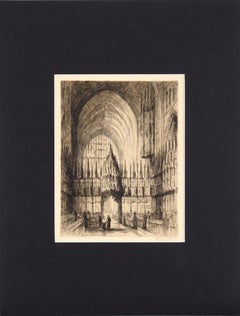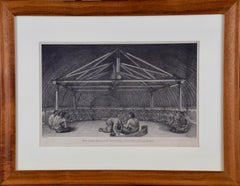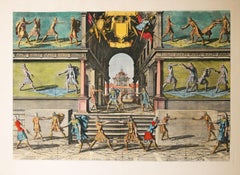Pierre Thibault Interior Prints
to
1
1
Overall Width
to
Overall Height
to
3
108
76
32
30
1
1
1
1
Artist: Pierre Thibault
Academie de l’Espee Tabula 2 prints Girarld Thibault Tab. XXXIII & Tab.IIII
By Pierre Thibault
Located in Paonia, CO
Two hand colored engravings from the Academie de l’Espee ( full title can be translated as Academy of the Sword: wherein is demonstrated by mathematical rules on the foundation of a mysterious circle the theory and practice of the true and heretofore unknown secrets of handling arms on foot and horseback ) by Girard Thibault...
Category
Early 17th Century Other Art Style Pierre Thibault Interior Prints
Materials
Engraving
Related Items
Chester Cathedral - Drypoint Etching in Ink on Paper
Located in Soquel, CA
Chester Cathedral - Drypoint Etching in Ink on Paper
Dramatic drypoint etching by J. Alphege Brewer (British, 1881-1946). This composition shows the interior of Chester Cathedral in Brewer's characteristic style - highly detailed and with strong contrast. The scene encompasses the cathedral from floor to ceiling, capturing the immense size of the building. There are several people in the scene which contribute to the sense of scale.
Signed by hand "J. Alphege Brewer" in the lower right corner.
Titled "Chester Cathedral" in plate, lower left corner.
Includes original card with artist's name.
Presented in a new black mat with foamcore backing.
Mat size: 16"H x 12"W
Paper size: 10.75"H x 7.75"W
James Alphege Brewer was well known in the early 20th century as a producer of color etchings of European cathedrals and other scenes of church, college, and community. He was born July 24, 1881, in the Kensington section of London, England, the son of Henry W. Brewer, noted artist of historical architecture and prominent convert to the Catholic Church, and the grandson of John Sherren Brewer, Jr., “the brilliant editor of the Calendar of Letters of Henry VIII.” His great uncle was E. Cobham Brewer, the polymath who compiled Brewer’s Dictionary of Phrase and Fable. Among his older siblings were the artist Henry C. Brewer and the organist and writer John Francis Brewer.
Brewer attended the Westminster School of Art in London, where his brother Henry also trained. In 1910, he married Florence Emma Lucas, an accomplished painter in oil and watercolor, whose father was the noted landscape artist George Lucas and whose great uncle was David Lucas, the famous engraver for John Constable. Florence's brothers Edwin and George assisted Brewer in the printing of Brewer's etchings.
Brewer exhibited at the Royal Academy (RA) and the Royal Institute of Painters in Watercolour (RI), at the Paris Salon of the Académie des Beaux-Arts, and in the shows of the Royal Cambrian Academy (RCA). He became an associate of the Royal Cambrian Academy in 1929 and a full member in the last two years of his life. He was also a member of the Hampstead Society of Artists, the Society of Graphic Art, and the Ealing Arts Club, where he was first Honorary Art Secretary and then Honorary Art Chairman. Most of Brewer's larger etchings were published by Alfred Bell...
Category
Early 20th Century Romantic Pierre Thibault Interior Prints
Materials
Paper, Ink, Drypoint
$396 Sale Price
20% Off
H 16 in W 12 in D 0.25 in
"King of the Friendly Islands" (Tonga); Engraving from Captain Cook's 3rd Voyage
By John Webber
Located in Alamo, CA
"Poulaho, King of the Friendly Islands, Drinking Kava" is an engraving created by William Sharp (1749-1824), from a drawing by John Webber (1752-1793), who was the artist on Captain James Cook's 3rd and final voyage of discovery. It was published in the atlas of "A Voyage to the Pacific Ocean Undertaken by the Command of His Majesty, for Making Discoveries in the Northern Hemisphere", the official British Admirality sanctioned journal published upon completion of the voyage in London in 1784 by Strahan & Cadell.
Captain Cook visited Tonga on his 3rd voyage, which he named The Friendly Islands because of the warm welcome he and his crew received, unlike some of the other more hostile Pacific islands. The engraving depicts Cook and his men observed a kava ceremony at the village of Mu’a on Tongatapu. King Paulaho sits in the centre foreground, his back to the spectator with a man kneeling before him. The ceremonial mat depicted behind Paulaho indicates that nobody was allowed to sit behind him. The figure in the centre holds a single cup, referring to the Tongan custom of offering the cup to the king first. Kava is native to the islands of the South Pacific and was first described for English readers in 1768 by Captain James Cook. The kava root has been used for centuries as a central feature of ceremonies and celebrations because it was able to bring about a calming and pleasant social atmosphere. The root was crushed and processed into coconut milk to become the focal ceremonial beverage, simply referred to as kava.
This engraving is presented in a Koa wood frame and a white mat. Koa wood is legendary in Hawaii. There are occasional faint spots, but the print is otherwise in very good condition. This amazing Koa wood is native to Hawaii and it is known for the deep rich colors and varied grain pattern. Koa has an honored heritage in Hawaii and is highly revered and sacred. The word “koa” means “warrior” in Hawaiian. The warriors of King Kamehameha the Great, created canoes and weapons from a wood plentiful on the Big Island of Hawaii. This wood became synonymous with the warriors themselves, and it became known as koa.
There are three other engravings listed from the official journal of Captain Cook's 3rd voyage available that are presented in identical Koa wood frames and mats (LU117324682422, LU117324684052, LU117324684032). They would make a wonderful grouping for a display of 2, 3 or 4 prints. A discount is available for a grouping depending on the number of items included.
Captain Cook is remembered as one of the greatest explorers and navigators in history. His explorations included Australia, New Zealand and islands of the South Pacific and the northwest coast of North America. Hawaii was discovered by Captain Cook during this voyage. Hawaii was originally called The Sandwich Islands in honor of The Earl of Sandwich...
Category
1780s Realist Pierre Thibault Interior Prints
Materials
Engraving
$2,375
H 18.25 in W 23.5 in D 0.88 in
'Jesus and the Woman at the Well, ' by Amand-Durand, Engraving
By Armand Durand
Located in Oklahoma City, OK
This early 19th century framed 35" x 31" engraving by artist Amand-Durand depcits an etching of 'Jesus and the Woman at the Well,' after the Dutch master, Rembrandt van Rijn. This poignant Biblical story is depicted by Arman-Durand in Rembrandt style...
Category
Early 19th Century Old Masters Pierre Thibault Interior Prints
Materials
Engraving
$1,200 Sale Price
20% Off
H 30.5 in W 26.5 in D 1.5 in
William Hogarth's "Analysis of Beauty": A Set of Two Framed 18th C. Engravings
By William Hogarth
Located in Alamo, CA
The two plates in this set were created utilizing both engraving and etching techniques by William Hogarth in 1753, originally as illustrations of his book on aesthetics, entitled "Analysis of Beauty". Due to their popularity, these plates were later published separately. The publication line in the lower right reads: "Designed, Engraved, and Publish'd by Wm. Hogarth, March 5th 1753, according to Act of Parliament." Hogarth's original copper plates were refurbished where needed by James Heath and engravings were republished in London in 1822 by Braddock, Cradock & Joy. This was the last time Hogarth's copper plates were used for printing. Most were melted during World War I for the construction of bombs.
These large folio sized "Analysis of Beauty" engravings are presented in antiqued gold-colored frames with double mats; the outer silk mats are light brown-colored and the inner mats are dark brown. Each frame measures 27.38" x 31.25" x 1.13". There is one tiny spot in the right margin of plate 1 and another in the lower margin; the latter could be from the printing process. The prints are otherwise in excellent condition.
The "Analysis of Beauty" series is in the collection of many major museums, including: The British Museum, The Metropolitan Museum of Art, The Tate Museum, The Chicago Art Institute and The Fine Arts Museums of San Francisco.
The first engraving (Plate 1) depicts a courtyard of statues which is filled with some of the most famous works of classical sculpture. The most important sculptures are surrounded by less impressive works. The Medicean Venus (#13) is in the center with a statue of Julius Caesar (#19) to the right, elevated on a pulley with a short, overdressed Brutus stands over the falling Caesar. The Apollo Belvedere (#12) is next. A judge stands to the right with his foot on a cherub (#16). Another crying cherub holds a gallows and wipes his tears with the judge's robe.
A sphinx (#21) and the drunken Silenus (#107) are below the Venus. Michaelangelo's torso (#54) and a statue of Antonius (#6) are seen in the foreground. The Farnese Hercules (#3) and a bust of another Hercules (#4) under two statuettes of Isis are also included in the scene.
The key to these objects is included in the form of a serpentine line winding around a cone (#26), Hogarth's "Line of Beauty". For Hogarth the winding line is an essential element of beauty in art. Hogarth's theory of beauty is communicated in this plate.
Plate 2 is thought to represent the Wanstead Assembly, with the Earl of Tynley and his household. It is an adaptation of a scene in the Happy Marriage series, which complements Hogarth's Marriage à la Mode...
Category
Mid-18th Century Old Masters Pierre Thibault Interior Prints
Materials
Engraving, Etching
$2,975
H 27.38 in W 31.25 in D 1.13 in
Bernard Sanders, Head of Girl
Located in New York, NY
For a print that's nearly one hundred years old it feels very contemporary.
Signed in pencil; titled in lower margin in pencil.
Category
Early 20th Century American Modern Pierre Thibault Interior Prints
Materials
Drypoint
James Dobie "The New Will" Color Engraving After Walter Dendy Sadler c.1894
Located in San Francisco, CA
James Dobie "The New Will" Color Engraving After Walter Dendy Sadler c.1894
Original 19th century color engraving
Engraved by James Dobie after artwork b...
Category
Late 19th Century Pierre Thibault Interior Prints
Materials
Engraving
$375
H 23.5 in W 28 in D 2 in
Interiors VII: The Train from Munich
By Peter Milton
Located in Middletown, NY
Interiors VII: The Train from Munich
Robert E. Townsend, 1991.
Resist ground etching and engraving with hand refinement in charcoal, pencil, stabilo, and eraser on BFK Rives white wove paper, 20 x 36 inches (507 x 914 mm), full margins. Signed, titled, dated and numbered 51/175 by the artist in pencil, lower margin. A brilliant, inky impression with luminous light and gradient tones. In excellent condition with one extremely minor and superficial spot of light tan adhesive residue on the verso, unobtrusive and not visible on the recto, with no other visible defects. With the blind stamp of the printer, Robert E. Townsend in the lower left margin. An especially fine impression in superb condition. [Milton 113].
When asked about this work in particular, Milton expressed that his favorite images were his darkest images, in theme, mood, and in ink. Milton, who has said that his work is infused with a postmodern awareness of the past, has focused here in a deeply personal way on a segment of history that continues to haunt us all. The work, published in 1991, evokes one of the darkest periods of European history, the eroding and erasing of European culture under fascism, and the eventual total loss of humanity. The Train from Munich is an especially relevant and emotional work for Milton, who created the piece for his wife, Edith, who escaped Munich in 1939 as a child on the fabled Kinderstransport. The Kinderstransport was a desperate rescue effort on the part of the British government to save as many Jewish children as possible by railway before borders closed on the precipice of the Second World War. Children left their parents behind, and boarded the trains alone, leaving the impending doom of Nazi Germany, they arrived in Great Britain as refugees. More than 10,000 children escaped the holocaust via the Kinderstransport. In Train from Munich, the image itself holds an almost immeasurable amount of symbolism; each inch of the matrix is a successful effort to confront this history in a way that is poignant through a series of motifs. We see the Café disappearing into a ghostlike memory of the past, an allegory to the disintegration of culture, while through the windows we can see a rampant, snarling dog; a portrait of Hitler's shepherd, Blondi. Blondi isn't the only notable figure in the composition. Milton has pointed out that the fading figure of the doorman at the Hotel Metropole is modeled after the artist and intellectual Marcel Duchamp, and the face of the young girl peering...
Category
1990s American Modern Pierre Thibault Interior Prints
Materials
Charcoal, ABS, Engraving, Etching
The Great Fire of London, 1666
By James Stow
Located in Middletown, NY
A rare early 19th century view of the Great Fire of London over Ludgate, enhanced with hand coloring.
London: Robert Wilkinson, 1811.
Copperplat...
Category
Early 19th Century English School Pierre Thibault Interior Prints
Materials
Handmade Paper, Engraving, Watercolor
Bernard Sanders, Young Girl (With Arms Crossed), about 1930
Located in New York, NY
Young Girl by Bernard Sanders (1906-1967) is a classic example of his masterful portraiture.
This is a drypoint. It is signed in pencil, titled in the lower left margin, and initial...
Category
1930s American Modern Pierre Thibault Interior Prints
Materials
Drypoint
$450
H 9.25 in W 6.07 in
G. Paterson "Dinner Party at a Mandarin's House" Engraving After T. Allom c.1840
Located in San Francisco, CA
G. Paterson "Dinner Party at a Mandarin's House" Original Engraving After T. Allom C.1840
Original engraving
Dimensions 8" wide x 5" high
The frame measures 20.5" wide x 18.5" hig...
Category
Mid-19th Century Realist Pierre Thibault Interior Prints
Materials
Engraving
$250
H 18 in W 20.5 in D 0.5 in
A Scene in the New Farce —as performed at the Royalty Theater
By George Cruikshank
Located in Middletown, NY
A Scene in the New Farce —as performed at the Royalty Theater
London: George Humphrey, 1821.
Etching and engraving on cream wove paper with extensive hand coloring in watercolor. 9 5/8 x 13 3/4 inches (244 x 348 mm), trimmed at the platemark. A beautiful impression of this large, intricate print...
Category
Early 19th Century Pierre Thibault Interior Prints
Materials
Watercolor, Engraving, Etching
$1,800
H 9.625 in W 13.75 in
"Inspection Tour in the Wine Vaults", 1876 Philadelphia Centennial Exposition
Located in Alamo, CA
This engraving is entitled "Philadelphia, PA- The Centennial Exposition - the Jury of Award on an Inspection Tour in the Wine Vaults of Agricultural Hall", ...
Category
Late 19th Century Naturalistic Pierre Thibault Interior Prints
Materials
Engraving
$475
H 21.88 in W 15.88 in D 1.25 in
Previously Available Items
Academie de l’Espee Tabula 2 prints Girarld Thibault Tab. XXXIII & Tab.IIII
By Pierre Thibault
Located in Paonia, CO
Two hand colored engravings from the Academie de l’Espee ( full title can be translated as Academy of the Sword: wherein is demonstrated by mathematical rules on the foundation of a mysterious circle the theory and practice of the true and heretofore unknown secrets of handling arms on foot and horseback ) by Girard Thibault...
Category
Early 17th Century Other Art Style Pierre Thibault Interior Prints
Materials
Engraving
Pierre Thibault interior prints for sale on 1stDibs.
Find a wide variety of authentic Pierre Thibault interior prints available for sale on 1stDibs. You can also browse by medium to find art by Pierre Thibault in engraving and more. Not every interior allows for large Pierre Thibault interior prints, so small editions measuring 36 inches across are available. Customers who are interested in this artist might also find the work of Marc Chagall, André Minaux, and Ludwig Favre. Pierre Thibault interior prints prices can differ depending upon medium, time period and other attributes. On 1stDibs, the price for these items starts at $900 and tops out at $900, while the average work can sell for $900.



